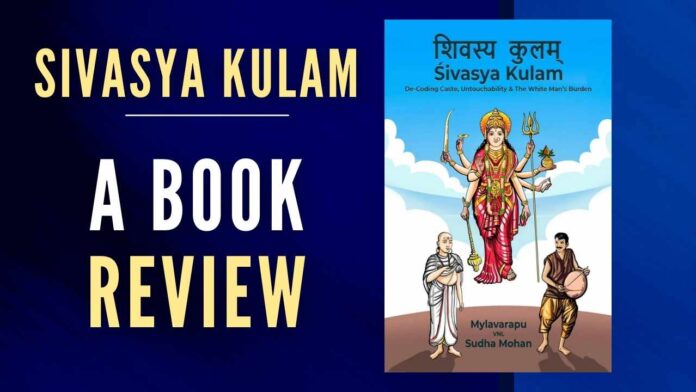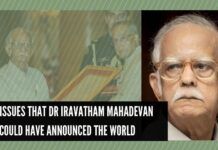
Introduction
The import of the word ‘caste’ from Europeans denoting varna/ kula carries a negative connotation across the world in this day and age. This is a clear signal of the fact that varna/ kula is not only misunderstood concept but also deliberately misconstrued by mainstream academia, and has been done so for centuries.
“Sivasya Kulam” is a book written with the intention of clearing this confusion from the Hindu point of view. In this book, the author in his well-researched and presented work has carried out a colossal task of demystifying the real import of the term caste in the context of varna, kula, and jati.
So far, whatever the modern world perceived of the caste system prevalent in India was from the colonial point of view, which may have been biased by the socio-economic, political, and cultural ends of their times but it was blatantly dragged out even in the post-colonial period by the state in order to create divisions in the society and get votes in the name of social service. The author does the work of the gods by taking up this project which is an eye-opener in this regard and gives us a more lucid picture of our own religious and social practices which were lost or demeaned in the wake of the colonial-missionary onslaught.
Mylavarapu Sudha Mohan pieces together the essential information from varied sources like Hindu scriptures, commentaries, and historical accounts as well as missionary work and colonial literature to build a complete picture of the fall in the sanctity of the varna/ kula system, and explains from the Hindu POV the true nature and working of the varna/ kula system. Apart from the varna/ kula system, the origin of the Dravidian theory and its role in tainting the varna/ kula system, the defilement of the tantric practices, explanation of the practices of Sati and Indian medical practices are also well detailed.
The author talks in detail about the concept of caste. He gives us an insight into the European notion of the word caste from the writings of scholar Edward Alsworth Ross and cites his book Principles of Sociology where he explains the Roman caste system. Quoting Alsworth Ross the Author says, “According to Ross, the Roman caste system forced people to follow the occupation of their fathers. This caste system did not allow the intermixture of different grades of society. There was no escape from this system. It was even said that ‘every individual was bound by his calling from not only his father’s but also his mother’s side of the family. People were not allowed to marry outside their guild. Ross said that the caste imposed a kind of servitude. His book suggests that the Roman or European caste was based on occupation or field of work.” This indicates that the European version of caste is entirely based on occupation, and also this book highlights class/ caste system was very much part of the European society. The author also cites various other European scholars like Samuel Dill, Rodney Glisan, and L.A. Thiers which helps us in understanding the European caste systems of Rome, England, and France which were mostly feudalistic and guild-based. He observed that the French caste system was called ‘estate’.
The author says that the European caste system was civil in nature, which hinged upon political power and wealth unlike that of Hindus – which were not based on the purity of race as claimed by Europeans but the concepts of varna and kula were the paths created on spiritual lines (viz Sadhana, Upasana) with these spiritual divisions manifesting into social divisions as well.
The author also points out the confusion in the western academia on the Hindu caste system. He highlights the confusion between Sociology and Anthropology. He also highlights the different hierarchical models that are being used by the westerners (viz Hocartian, Dumontian), and also states that there was another model of hierarchy which was a lived experience of different varna/ kula and he also states that this factor was ignored by the colonial forces. He also highlights that by the late 20th century British sociology was labeled by scholars as “unashamedly western-centric”, which means that the western research on caste was biased thereby presenting a distorted view of varna/ kula.
He presented clear evidence from the missionary and colonial records as to how the varna/ kula system hindered missionary activities and the conversion of natives has been pointed out by the author. For this the author cites the book by (Edited) Joseph Roberts titled ‘Caste, in its Religious and Civil Character, Opposed to Christianity’ published in the year 1847 where the extracts of various letters and speeches by various Bishops of Indian churches are found. He also quotes the 1850 missionary meeting of Madras on the subject of caste.
Presenting the case of the real import of the concepts of varna/ kula in the Indian context, the author cites P V Kane where the concepts of varna/ kula and jati are distinguished, and the author went on a journey, clearing a major doubt as far as our social structure is concerned.
Sudha Mohan rightly points out that the social behavior of all kulams and varnas is decided by their Achara. It is Achara that decides and permits social mobility, thereby concluding that jati is an Achara or religion-based division, and not a racial division. He quoted a few verses of Hindu Sastras/ interpretations which indicate such an opinion.
The Europeans created the Aryan-Dravidian divide in order to create fractures in the Hindu society which would make it easier for missionaries to convert native Indians. The author then moves to Bishop Caldwell’s theory of Dravidianism based on linguistics and his inaccurate and misrepresentation of Shanars of Tirunelveli whereby he tried to show the devil temples as worshipped by Shanars as non-Brahmanical and primitive. This artificial schism between demonolatry and Grama Devata worship by Shanars was milked by Caldwell and his subsequent missionaries.
Then the author took up the complex political topic of Dravidianism in South India. He says in order to understand Dravidianism, we must understand demonolatry and demonology. He explains the demonology in the Dravidian context and the malicious and artificial Aryan-Dravidian divide that is based on the demonolatry and Gramadevatas. The next section covers what the 19th century Europeans referred to as Dravidianism which they used to vilify varna/ kula and Gramadevata system and misused or misquoted the Tantric/ Atharvana vedic concepts. The Europeans used the term Dravidian to identify a race while clearing the fact that the term ‘Dravida’ was used by many to refer to a geographical location.
The author clears the position taken by Europeans who accuse Hindus of promoting the slavery system by citing the 1871 Madras Town Census report. This report contained information about slave trading in the 17th Century. According to this information, South Indians and their children were kidnapped and shipped as slaves to other countries. He claims that there is a lot of information hidden on the issue of indentured labor. British and Europeans openly boast about the abolition of slavery in the 19th century. But the human trafficking never stopped and the author says that the concept of indentured labor replaced slavery and this even continued in the 20th century.
The author then talks about the missionary writings such as Ziegenbalg, Abbe Dubois, and Samuel Mateer among others who linked devil worship, black magic, exorcism, devil dancing, possession, etc. to be separate from Hinduism which could not be true given that such elaborate and pedantic ritualistic practices could not exist without religious backing or scriptural guidance.
The missionaries used Sati tradition as justification for evangelization or subsequent reform or westernization of Hindus. The author then says that Professor Minakshi Jain already disputed the missionary statistics on Sati, and says, “If we believe the missionary numbers on Sati for a moment, then those numbers are also saying that diseases were rampant in the British raj of that time. This could also mean that the greed of the British/ Europeans could have contributed to the collapse of the native medical system. Due to this many men, and women with leprosy or other diseases could have committed Sati. Or women could have committed Sati because their husbands were dying due to diseases.” The author concludes from his sources and citations that Sati was not only a rare practice but was committed by men and women belonging to both Hindu and Islamic religions, those of whom were affected by the contagious disease leprosy.
Thus, he connects demonolatry (Bhuta Vidya, Buta Vaidyam) to the Indian medical systems and explains their relation to Hindu society.
Conclusion
If not for this book I would never learn about the varna /kula system’s intricate working as it existed in our glorious past, the missionary hand in distorting our customs and traditions, and the real reason why they want to annihilate caste in its entirety.
I am personally thankful to the author for bringing to light such important concepts and facts before us which were long lost and would have been lost if not for this noble task. This book has armed me with crucial information and knowledge that will help me defend my position as a Hindu, my religion, culture, and traditions.
Get a copy of the book ‘Sivasya Kulam’ from here[1][2].
Note:
1. Text in Blue points to additional data on the topic.
2. The views expressed here are those of the author and do not necessarily represent or reflect the views of PGurus.
Reference:
[1] Sivasya Kulam: Decoding Caste, Untouchability & The White Man’s Burden – HinduEShop
[2] Sivasya Kulam Paperback – Jan 01, 2022, Amazon.in
PGurus is now on Telegram. Click here to join our channel and stay updated with all the latest news and views
For all the latest updates, download PGurus App.










